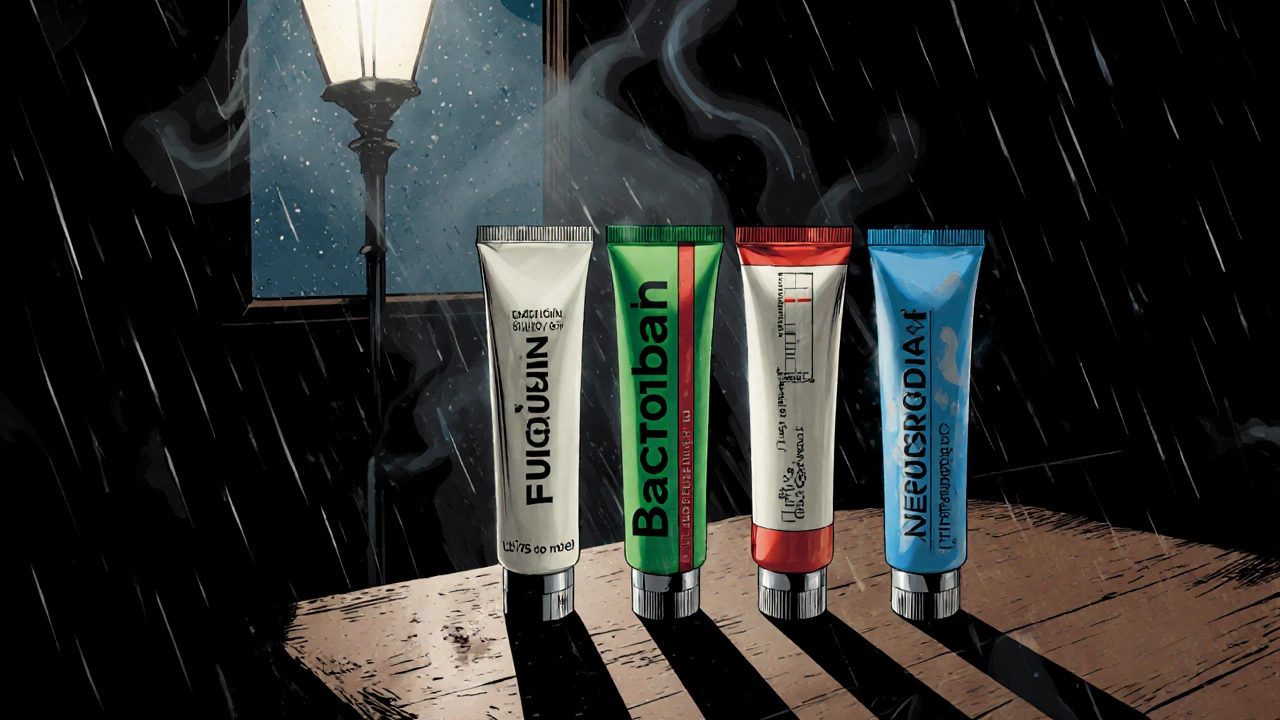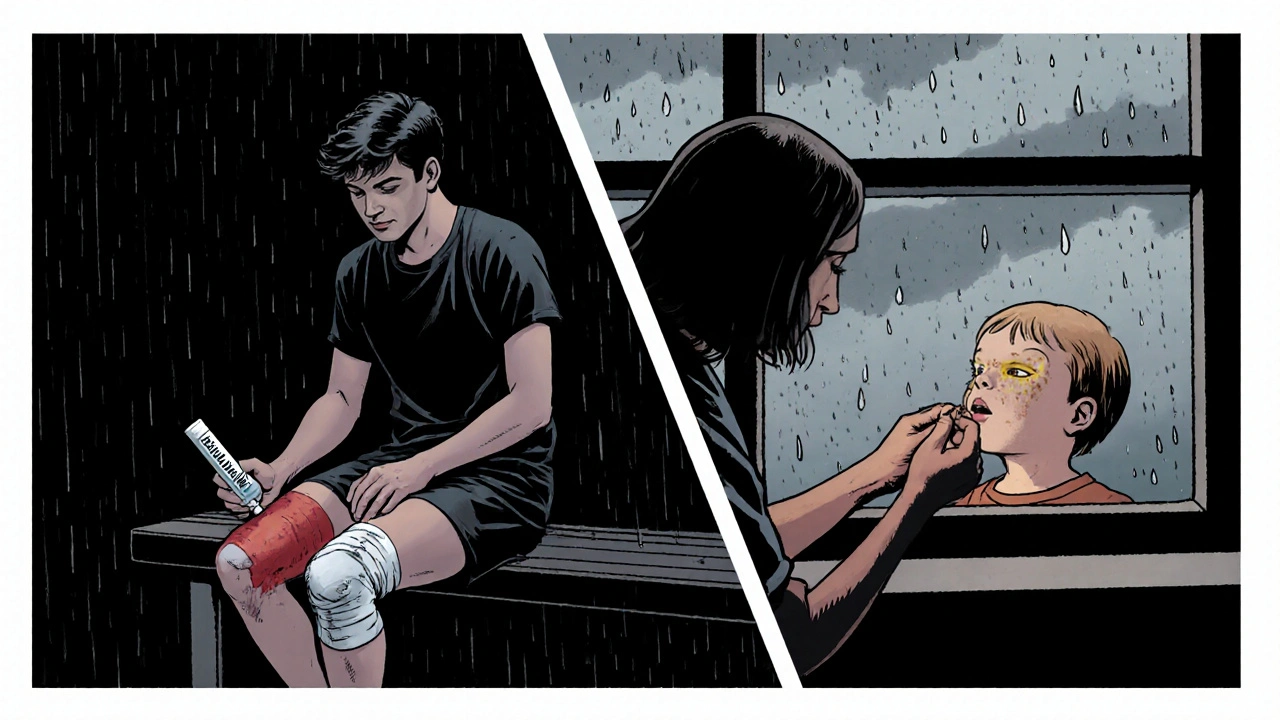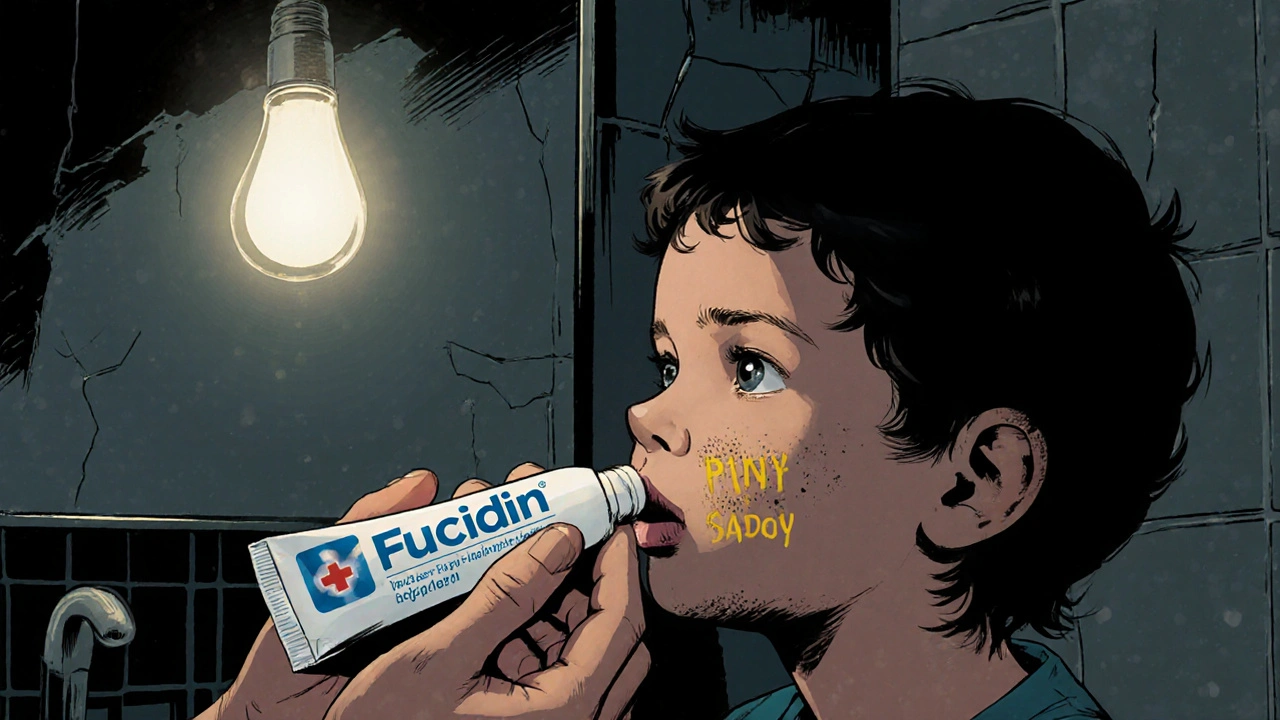16 Oct 2025
- 9 Comments
Topical Antibiotic Decision Checker
Find Your Best Topical Antibiotic Match
Based on Australian clinical guidelines, this tool helps you determine the most appropriate topical antibiotic for your specific situation. Select the appropriate options below:
Recommended Topical Antibiotic
When a skin infection pops up, choosing the right cream can feel like a gamble. Fucidin Cream is a prescription‑only ointment that contains fusidic acid, a narrow‑spectrum antibiotic targeting gram‑positive bacteria such as Staphylococcus aureus. It’s popular in Australia for conditions like impetigo, infected eczema, and small cuts. But you’ll also hear names like mupirocin, clindamycin, or neomycin tossed around. Which one actually fits your needs?
What Makes Fucidin Cream Unique?
Fusidic acid works by blocking protein synthesis in bacteria, specifically binding to elongation factor G (EF‑G). This stops the microbes from growing, letting your immune system clear the infection. Because it’s not a broad‑spectrum agent, resistance develops more slowly compared with some older creams.
Key attributes of Fucidin Cream include:
- Concentration: 2% fusidic acid in a hydrophilic base.
- Typical use: 2-3 times daily for 5‑7 days.
- Safety: Minimal systemic absorption; safe for most ages, including children over 1 month.
When Do You Actually Need a Topical Antibiotic?
Not every rash calls for an antibiotic. Mild eczema, dry skin, or fungal infections respond better to moisturisers or antifungals. Use a topical antibiotic when you see clear signs of bacterial infection: redness, warmth, swelling, pus, or a honey‑colored crust (impetigo).
Common culprits are Staphylococcus aureus and Streptococcus pyogenes. In Australia, MRSA (methicillin‑resistant Staph) has been on the rise, nudging clinicians toward agents that retain activity against resistant strains.
How Do the Main Alternatives Stack Up?
Below is a side‑by‑side look at the most frequently prescribed alternatives. The table focuses on the attributes that matter to patients: spectrum of activity, typical indications, known side effects, and approximate out‑of‑pocket cost under the Australian PBS (Pharmaceutical Benefits Scheme).
| Medication | Active Ingredient | Typical Use | Contra‑indications / Common Side Effects | Approx. Cost (AU$) |
|---|---|---|---|---|
| Fucidin Cream | Fusidic Acid 2% | Impetigo, infected eczema, minor cuts | Rare allergic dermatitis; not for deep tissue infection | ~$12 (PBS‑subsidised) |
| Bactroban | Mupirocin 2% | Impetigo, folliculitis, MRSA‑colonised wounds | Contact dermatitis; avoid in patients with known mupirocin allergy | ~$18 (PBS‑subsidised) |
| Dalacin T | Clindamycin phosphate 1% | Acne vulgaris, infected dermatoses | Dryness, itching; not for patients with clostridial infection risk | ~$15 (over‑the‑counter) |
| Neosporin | Neomycin, Bacitracin, Polymyxin B | Minor cuts, abrasions, burns | High allergy rate (up to 10%); not for deep infections | ~$8 (pharmacy shelf) |
| Retapamulin | Retapamulin 1% | Impetigo (especially in children) | Mild burning sensation; avoid in pregnant women (category B2) | ~$22 (private) |

Pros and Cons - A Quick Decision Guide
Summarise the trade‑offs in plain language. Use this as a mental checklist when you’re staring at the pharmacy shelf or your doctor’s prescription pad.
- Fucidin Cream:
- Pros - Targeted against Staph, low resistance, affordable under PBS.
- Cons - Limited activity against streptococci, not ideal for MRSA‑dominant infections.
- Bactroban (Mupirocin):
- Pros - Strong against MRSA, good for nasal decolonisation.
- Cons - Higher cost, may cause more local irritation.
- Dalacin T (Clindamycin):
- Pros - Effective for acne‑related bacterial overgrowth.
- Cons - Risk of C. difficile overgrowth if absorbed; not first‑line for simple impetigo.
- Neosporin (Neomycin combo):
- Pros - Widely available, cheap.
- Cons - High allergy potential, limited bacterial spectrum.
- Retapamulin:
- Pros - FDA‑approved for pediatric impetigo, low resistance profile.
- Cons - Expensive, not on PBS, limited supply.
Real‑World Scenarios - Which Cream Wins?
Scenario 1 - A toddler with honey‑crusted impetigo on the face. Pediatric guidelines in Victoria recommend either Fucidin or Retapamulin. If cost is a concern and the strain is likely Staph‑aureus, Fucidin is the sensible first try.
Scenario 2 - An athlete with a MRSA‑positive wound on the thigh. Here, Bactroban shines because of its proven activity against MRSA. Your physiotherapist may even suggest a short 5‑day course.
Scenario 3 - A teenager battling acne with occasional pimples that get infected. Dalacin T offers dual action: it treats the bacterial component of acne and can handle secondary infection without adding a separate antibiotic.

How to Use Topical Antibiotics Safely
- Wash hands and the affected area with mild soap; pat dry.
- Apply a thin layer of the cream, covering the entire lesion but not the surrounding healthy skin.
- Do not cover with occlusive dressings unless directed by a clinician.
- Finish the prescribed course even if the lesion looks better after 2‑3 days.
- Watch for signs of worsening infection (increased redness, swelling, fever) and seek medical advice.
Remember, misuse of topical antibiotics fuels resistance just like oral drugs. Reserve them for confirmed bacterial infections.
Frequently Asked Questions
Can I use Fucidin Cream on a fungal infection?
No. Fusidic acid targets bacteria only. For athlete’s foot or ringworm you need an antifungal such as terbinafine.
Is Fucidin Cream safe during pregnancy?
Current Australian guidelines list fusidic acid as pregnancy category B2, meaning no evidence of harm in animals but limited human data. Discuss with your GP before use.
How long does it take for the cream to work?
Most patients see reduced redness and crusting within 48‑72hours. Full clearance typically occurs after 5‑7days of twice‑daily application.
Can I use Fucidin on children under 1month?
The product is not recommended for infants younger than 1month because safety data are lacking. Consult a paediatrician for alternatives.
What should I do if I develop a rash after using the cream?
Stop using the product immediately and wash the area with mild soap. Contact your doctor - it could be an allergic contact dermatitis.
Bottom Line - Making the Right Choice
There’s no one‑size‑fits‑all answer. If you need a cost‑effective, low‑resistance option for classic impetigo, Fucidin Cream is usually the go‑to. For MRSA‑related wounds or when you suspect a broader bacterial spectrum, step up to Bactroban or Retapamulin. Always match the drug to the infection type, patient age, and any known allergies.
Talk to your pharmacist or GP, confirm the diagnosis, and follow the dosing schedule. Doing so will clear the infection faster and keep resistance at bay.


Mark Conner
October 16, 2025If you wanna treat a cut, use a home‑grown remedy, not some fancy Aussie prescription.
Caley Ross
October 17, 2025I get the pride thing, but skin infections don’t care about borders; the active ingredient matters more than the label. A fusidic acid formulation will still work the same way on an American body as it does down under. What really decides success is proper application and finishing the full course. Skipping out because of brand loyalty can let bacteria linger and bounce back.
Bobby Hartono
October 19, 2025When you’re looking at the table of topical antibiotics, it’s easy to feel overwhelmed by the names and numbers, but the underlying principle is pretty straightforward. All of these creams target the same basic problem: a bacterial invasion of the skin’s protective barrier, and they each do it with a slightly different mechanism of action. Fusidic acid, for instance, latches onto elongation factor G and stops protein synthesis, which is why resistance tends to develop more slowly than with some broad‑spectrum agents. Mupirocin, on the other hand, binds to isoleucyl‑tRNA synthetase and is especially potent against MRSA strains, which explains its higher price tag in the PBS schedule. Clindamycin’s role is a bit more niche; it’s great for acne because it can reduce the Propionibacterium acnes load, but you have to watch out for the risk of C. difficile if it ever gets absorbed systemically. The triple‑antibiotic mix in Neosporin is cheap and convenient for minor cuts, yet the allergy rate is surprisingly high, so you’ll see a fair number of people developing contact dermatitis after a few days of use. Retapamulin is a newer player that’s been praised for low resistance development, but its cost and limited availability on the PBS make it a second‑line choice for many families. The practical takeaway here is that you should match the cream not just to the type of bacteria you suspect, but also to the patient’s age, allergy history, and budget constraints. In toddlers, for example, the safety profile of fusidic acid is reassuring, whereas children with a known neomycin allergy should steer clear of Neosporin entirely. For athletes with frequent skin breaks who might be colonised with MRSA, Bactroban becomes the go‑to option despite the extra dollars. And finally, remember that topical antibiotics are adjuncts, not replacements for good wound care – cleaning the area, keeping it dry, and applying a thin layer of the appropriate ointment are the basics that will win the battle more often than the choice of brand.
George Frengos
October 20, 2025That’s a thorough rundown, thank you for laying it out so clearly. It’s encouraging to see the emphasis on proper hygiene alongside the medication choice. Matching the cream to the patient’s specific situation really does make a difference. Keep up the great work sharing these practical insights.
Jonathan S
October 21, 2025Honestly, slapping on a cheap over‑the‑counter ointment when you could afford a prescription‑grade product is a moral failing 😒. We have the data, we have the guidelines, and yet people still gamble with sub‑par meds. It’s not just about saving a buck; it’s about preventing a future outbreak of resistant bacteria 🙈. Choose wisely, because the consequences of cheap choices ripple far beyond your own skin.
Charles Markley
October 22, 2025While the sentiment echoes a populist ethic, one must critically interrogate the epistemic foundations of such binary moralization. The pharmacokinetic profile of fusidic acid, characterized by negligible systemic absorption (Cmax < 1 µg/mL), predicates its safety in pediatric cohorts, a nuance often obfuscated by reductive rhetoric. Moreover, cost–benefit analyses, leveraging incremental cost‑effectiveness ratios (ICERs), demonstrate that Fucidin’s PBS‑subsidised pricing yields a favorable economic horizon when juxtaposed against the higher marginal cost of mupirocin, especially under a discounted recurrent usage model. Dismissing these data points in favor of ad hominem judgments undermines the evidentiary paradigm essential to antimicrobial stewardship. Hence, a judicious, data‑driven selection process supersedes moralistic branding.
L Taylor
October 23, 2025One could argue that the very act of choosing a topical antibiotic is a microcosm of the larger ethical dialectic between individual autonomy and collective health imperatives. The choice, however mundane, reverberates through the microbial ecosystem, influencing resistance trajectories in ways that are both quantifiable and philosophically resonant.
Matt Thomas
October 24, 2025Just a heads up – watch the commas and keep “its” distinct from “it’s”. Also, “reverberates” isn’t a common Aussie term, maybe say “echoes”. Otherwise solid point.
Nancy Chen
October 25, 2025Did you ever notice that the big pharma giants never talk about these cheap Aussie creams? Something’s definitely being hidden – they want you to buy the pricey stuff while the real cure sits on the shelves, unnoticed. Keep an eye out for the silence.